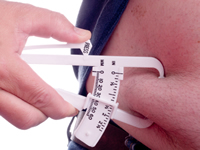Example : A 2.00 m tall man with weigh of 100 kgs. BMI = Weight in Kg / Height in Meters Sq.
His BMI is then (100/2^2) = 25.0)
According to BMI categories of weights are as follow:
BMI below 18.5 is defined as 'underweight‘
BMI between 18.5 and 24.9 is 'normal weight' or 'healthy weight range‘
BMI of 25.0 - 29.9 is defined as 'overweight‘
BMI of 30.0 and above is defined as 'obese'.
 BMI measurements are not always perfect and does not give full picture
of body composition. Body composition is the term used in reference to
body fat percentage to lean body mass. The fat component is ususlly
referred to as fat massor percentage body mass and non-fat components
of body are referred to as lean body mass. This is what we call lean
body mass index and we now know is the most important in determining
factor in healthy weight of an individual.
BMI measurements are not always perfect and does not give full picture
of body composition. Body composition is the term used in reference to
body fat percentage to lean body mass. The fat component is ususlly
referred to as fat massor percentage body mass and non-fat components
of body are referred to as lean body mass. This is what we call lean
body mass index and we now know is the most important in determining
factor in healthy weight of an individual. Let us put some testing questions like-Can you be leaner yet, gain weight ?
Answer is,yes. Simply, it rest with body fat percentage of an individual or what we can call as body fat percentage and it's ratio with lean mass.This is because they have so much muscle mass.
 Let
us take the example of someone weighing 200 pounds with a body fat
percentage of 25%. He is carrying around 50 pounds of fat. Another
person, also weighing 200 pounds with only a 10% body fat would be
carrying only 20 pounds of fat.
Let
us take the example of someone weighing 200 pounds with a body fat
percentage of 25%. He is carrying around 50 pounds of fat. Another
person, also weighing 200 pounds with only a 10% body fat would be
carrying only 20 pounds of fat. Now muscles weighs more than fats and muscles are more compact than fat. One kg of fat would make you 40% more larger than 1kg of muscle.
Obviously, person person with 10% of body fat going to be much more leaner than the one with 25% of body fat even though scale may read same for both. This is because they have so much muscle mass. This means a more muscular version of your current body would make you look leaner and also fit you into clothes which are down on size. What it also means is that, you may have got fatter even though the scale says you haven't ?
 Let us take another question - Can you get fatter, even though the scale says you haven't gained weight ?
Let us take another question - Can you get fatter, even though the scale says you haven't gained weight ? answer is again yes, As you can see from above illustration, your weight is of little help in determining how fat you are or even how good you look because in both cases the two subjects weighed the identical amount. According to measurements such as the Body Mass Index (BMI) used by traditional medicine some super athletes are considered obese even though they may have about 4% body fat. This is because they have so much muscle mass
By the same token, some people according to the BMI scale are of ideal body measurements and are at their target weight, may have body fat of 20-25 or even 30 % and are actually over fat and out of shape. (Ideal range of body fat percentage for males is 12- 18 % and females 14-22%).What it also means is that, you may have got fatter even though the scale says you haven't ?
So, one of the best ways to begin to assess your personal shape is to look at your personal body fat %. Once we have a reading on that, it is a first basis for measuring your current shape and a yardstick for any future progress you might make on any program.You may be in your best physical shape ever, but your bathroom scale may not reflect the gains you have
Few fundamental facts about the fats :-
- One kg or fat would make you 40% more larger than 1kg of muscle.
- On an average we gains about 1lb or about 1/2kg of body fat /yr. from age of 25 years onwards.
- Body fat is accumulated under the skin we call sub-cutaneous fat and in and around all ourorgans. Excess fat acculation around organs can stresses our vital organs-Heart & Lungs,
 Excess
fat becomes a massive generator of hormones into the body with the
potential to completely imbalance our natural hormone levels
Excess
fat becomes a massive generator of hormones into the body with the
potential to completely imbalance our natural hormone levelsWhat about Waste line ?
Fat in the abdomen is more strongly associated with adverse health outcome than fat deposited elsewhere in the body. As mentioned above, BMI alone is not necessarily a good predictor of your total body fat level, or of your level of abdominal fat. Therefore, you need to take into account waist circumference as well as BMI to determine how 'healthy' you are with respect to total body fat and body fat distribution.
 To
measure waist circumference, pass a tape measure horizontally around
your waist at the level of the navel, breathe out, and measure the
circumference before you breathe in again. A waist circumference
greater than about 102 cm (men) or 88 cm (women) indicates excessive
abdominal fat.
To
measure waist circumference, pass a tape measure horizontally around
your waist at the level of the navel, breathe out, and measure the
circumference before you breathe in again. A waist circumference
greater than about 102 cm (men) or 88 cm (women) indicates excessive
abdominal fat.There may also be differences between people of different origins with respect to appropriate BMI and waistline circumferences. For example, for the same BMI and waist circumference, Australian Aborigines, people of Asian origin and South Pacific islanders appear to be at higher risk of developing metabolic syndrome than people of European origin.
Excess body fat around the waist is one of the best indicator of your current fitness and health levels? Risk of develpment of Metabolic Syndrome is greater with people who have waste circumferences greater than about 102 cm (men) or 88 cm (women).
Risk of Myocardial Infarction (heart attack) is best measured using a persons waist circumference rather than a BMI (Body Mass Index) or other outdated means.



Comments
{tag_commentlist}